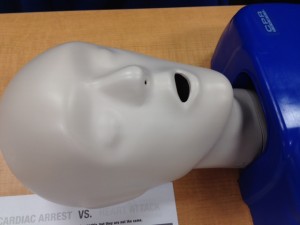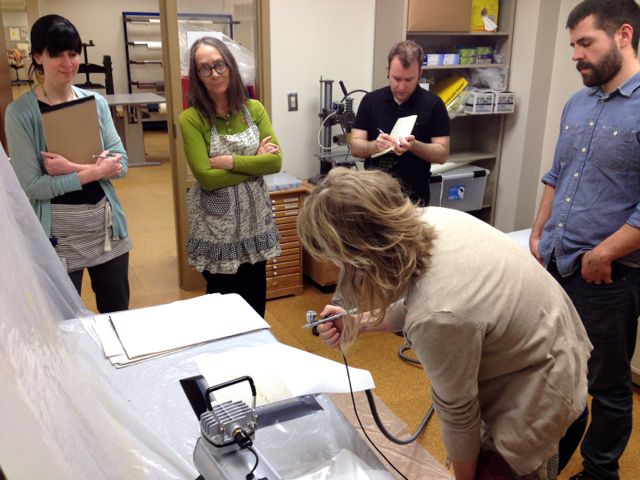Every now and then we take some time to practice new techniques we learn at conferences and workshops. At the 2015 AIC Annual Conference, Erin learned how to use an airbrush and how it could be applied to conservation. Last week she showed us what she learned, and gave us all time to practice with the airbrush. Erin has experimented with tide line removal and tissue toning with the airbrush. We brainstormed other ways we could use this method, too, including consolidation and perhaps spot washing on the suction platen. Have you used an airbrush in your lab? Let us know in the comments how and to what effect.
Tag Archives: training
Preservation of a Different Kind
This post is only slightly off topic, but it is preservation related of a kind. Our University Archivist and myself went over to Duke Hospital to take part in a compression-only CPR class today. This session focused on what to do if an adult or teenager collapses due to cardiac arrest.

We learned the proper way to apply compressions following the “three C’s.”
- Check to see if the person is conscious
- Call 911; and if there is an AED in your building, ask someone to get that, or get it yourself
- Compressions at at least 100 beats per minute
If you need help keeping the 100 beats-per-minute rhythm, the American Heart Association has put together a Spotify list of music with the perfect beat to do CPR compressions. We also learned how to use an Automated External Defibrillator or AED, which led me to wonder if the library has one. I’ve sent an email to our building security manager to find out.
There is a very brief video by the American Heart Association that demonstrates the compression-only CPR technique.* You do not need to be certified to do this method of CPR, and it does not involve checking for a heart beat, sweeping the mouth, or providing breaths.

At the beginning of the class we were asked to share this information with eight people, and ask them to share as well. Consider yourself part of my eight people. Now go and share!
*A Facebook reader sent us this link to the British Heart Association’s compression-only CPR video with Vinnie Jones. Very funny.
Paste Paper Workshop
Just before leaving Trent Hall, the Conservation staff took advantage of the outdoor space to participate in a paste paper workshop on July 31, 2008. This technique of creating decorative paper using pigments and wheat starch paste is one of the earliest forms used for covers and endpapers. It is commonly found on materials from the 16th to 18th centuries and is still used today.
We used samples from the Jantz collection as inspiration to create, and in some cases re-create, patterns that are both decorative as well as useful for our work. Working outside on a hot and humid summer day was interesting, especially when it rained and we had to move into the women’s restroom in Trent Hall. Luckily for us there was plenty of space in the old dorm restroom to complete our work! Duke University Library staff may read more about this in the September 2008 IB.
In other news, the Conservation Lab has returned to Perkins Library along with the Digital Production Center and Winston Atkins. We moved on August 25-26th, and have been unpacking and settling into our new space. At some point in the near future we hope to have a formal open house to officially open the new lab.


